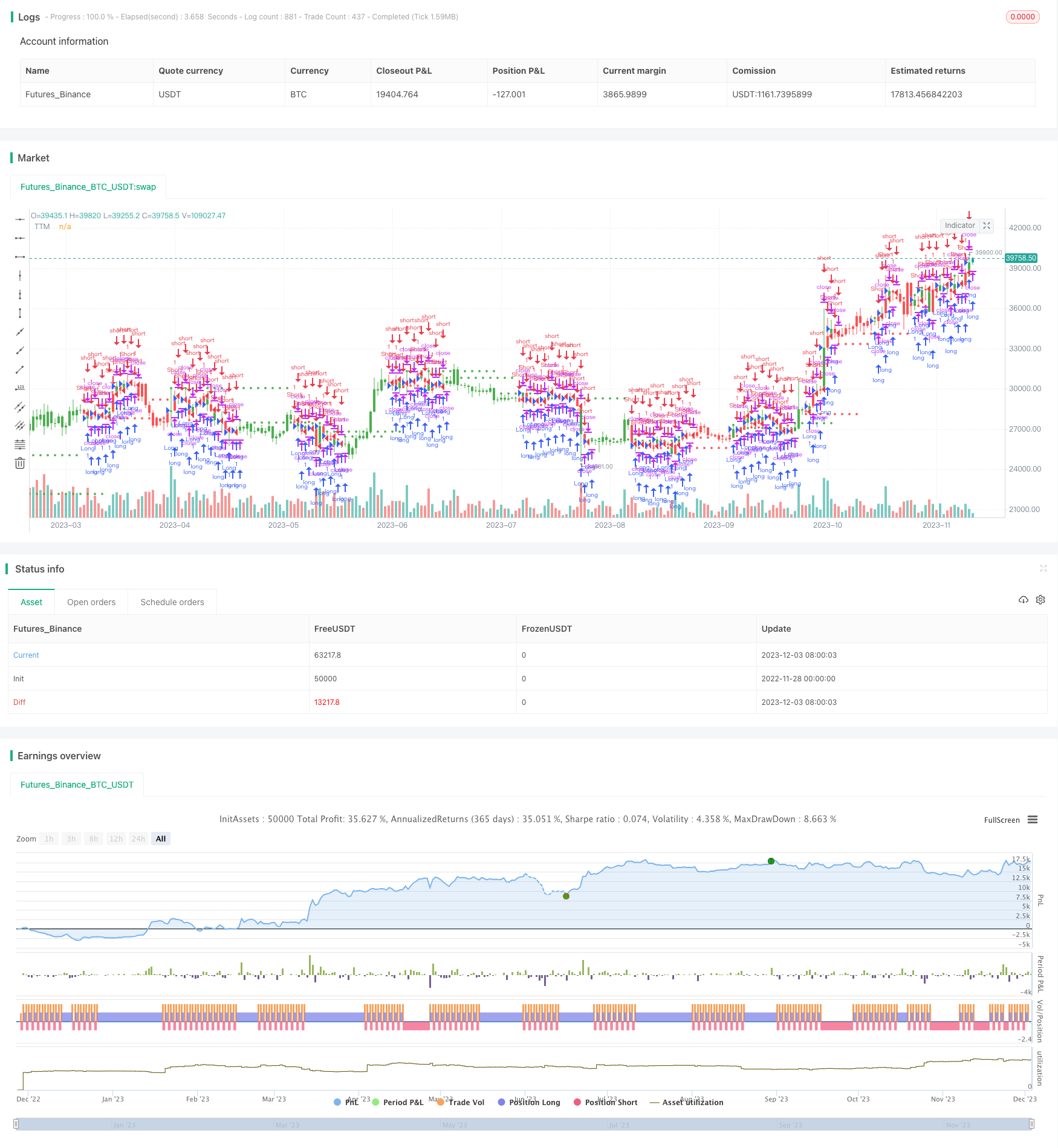
概述
该策略名称为“基于价格反转的TTM银隼震荡策略”(TTM Falcon Oscillator Reversal Strategy)。它是一个利用价格反转信号来寻找买卖点的震荡指标。
该策略的主要思想是利用价格形态判断趋势反转,当价格出现三根K线形成新的高点或低点时,判断为价格反转信号,采取相应的做多做空操作。
策略原理
该策略通过观察K线的收盘价变化判断价格反转。具体逻辑是: 1. 当第一根K线的收盘价低于第二根K线的收盘价时,记录信号为1;当第一根K线的收盘价高于第二根K线的收盘价时,记录信号为0。 2. 如果上一个信号为1(代表价格下跌),同时第二根K线和第三根K线中有任意一根K线的收盘价低于第一根K线的收盘价,则判断为价格反转信号,发出卖出信号。 3. 如果上一个信号为0(代表价格上涨),同时第二根K线和第三根K线中有任意一根K线的收盘价高于第一根K线的收盘价,则判断为价格反转信号,发出买入信号。
通过这个方法,该策略能快速判断价格反转,在反转点前后及时入场。
策略优势
该策略主要有以下优势:
反应迅速。通过仅比较三根K线的大小关系来判断价格反转,能够快速判断市场反转点,及时入场。
减少交易频率。相比其他震荡策略,该策略只在价格明确反转时才发出信号,可以有效减少不必要的交易次数。
parameter优化空间大。策略优化潜力大,可调整K线周期参数以适应不同市场环境。
可量化回测。该策略可直接在量化平台中实现自动回测,大幅提高测试效率。
逻辑简单易理解。新手交易者也易于理解和掌握该策略的核心逻辑。
策略风险
该策略也存在一定的风险,主要体现在:
价格震荡范围大。当价格波动过于剧烈时,反转信号可能不准确,容易追高杀低。
参数优化难度大。K线周期参数的选择对策略表现有很大影响,需要大量优化找到最佳参数组合。
交易次数过于频繁。在某些市场环境下,反转信号可能过于频繁,造成交易次数过多。
反转时间无法确定。该策略无法判断价格反转后新的趋势会持续多久,存在无法持有趋势的风险。
对应解决方法是:适当调整参数缩小价格波动范围,在多种市场环境中充分优化测试,并设置止损以控制单笔损失。
策略优化方向
该策略主要可从以下几个方向进行优化:
K线周期优化。适当调整K线的时间周期参数,找到最佳的参数组合。
增加过滤条件。在发出信号前增加其他辅助条件判断,避免错误信号。
增加止损机制。设置合理的止损点,控制单笔损失。
结合其他指标。融合均线、波动率等其他指标信号,提高决策准确性。
参数自适应优化。让参数能根据市场环境变化而动态调整,使策略更具鲁棒性。
通过这些优化,可以大幅提升策略的稳定性、胜率和盈利能力。
总结
总的来说,该策略利用价格形态判断反转点的思路非常简单直接,逻辑清晰易于理解,且参数优化空间较大,可按照个人偏好进行调整。但也存在一定概率上signal过于频繁和持仓时间控制不当的风险。通过严格的回测和稳健的参数优化,该策略可以成为高效盈利的震荡类交易策略之一。
/*backtest
start: 2022-11-28 00:00:00
end: 2023-12-04 00:00:00
period: 1d
basePeriod: 1h
exchanges: [{"eid":"Futures_Binance","currency":"BTC_USDT"}]
*/
//@version=2
////////////////////////////////////////////////////////////
// Copyright by HPotter v2.0 10/01/2018
// TTM scalper indicator of John Carter’s Scalper Buys and Sells. The methodology
// is a close approximation of the one described in his book Mastering the Trade.
// The book is highly recommended. Note the squares are not real-time but will
// show up once the third bar has confirmed a reversal.
//
//You can change long to short in the Input Settings
//WARNING:
//- For purpose educate only
//- This script to change bars colors.
////////////////////////////////////////////////////////////
strategy(title="TTM scalper indicator", overlay = true)
reverse = input(false, title="Trade reverse")
triggerSell = iff(iff(close[1] < close,1,0) and (close[2] < close[1] or close[3] <close[1]),1,0)
triggerBuy = iff(iff(close[1] > close,1,0) and (close[2] > close[1] or close[3] > close[1]),1,0)
buySellSwitch = iff(triggerSell, 1, iff(triggerBuy, 0, nz(buySellSwitch[1])))
SBS = iff(triggerSell and buySellSwitch[1] == false, high, iff(triggerBuy and buySellSwitch[1], low, nz(SBS[1])))
clr_s = iff(triggerSell and buySellSwitch[1] == false, 1, iff(triggerBuy and buySellSwitch[1], 0, nz(clr_s[1])))
clr = iff(clr_s == 0 , red , green)
pos = iff(clr == green, 1,
iff(clr == red, -1, nz(pos[1], 0)))
possig = iff(reverse and pos == 1, -1,
iff(reverse and pos == -1, 1, pos))
if (possig == 1)
strategy.entry("Long", strategy.long)
if (possig == -1)
strategy.entry("Short", strategy.short)
barcolor(possig == -1 ? red: possig == 1 ? green : blue )
plot(SBS, color=clr, title="TTM", style = circles, linewidth = 2)